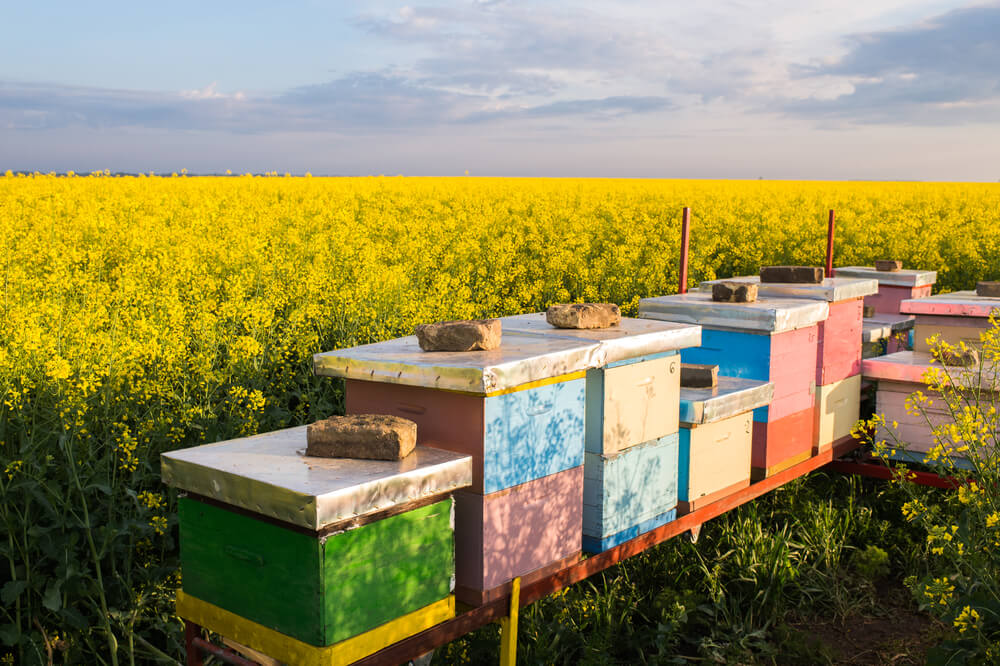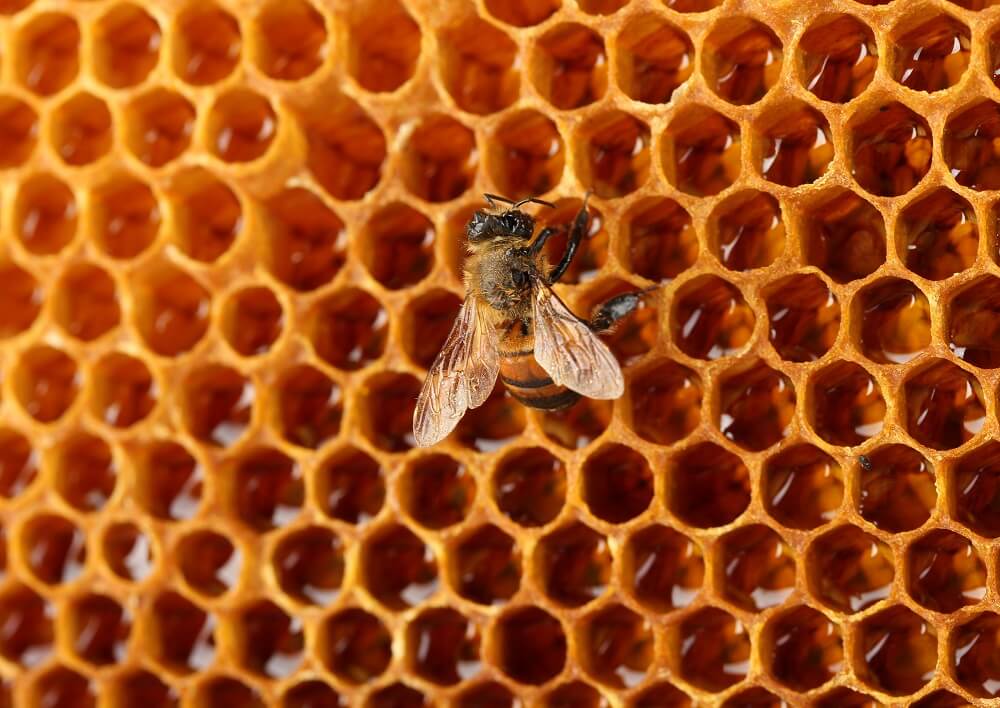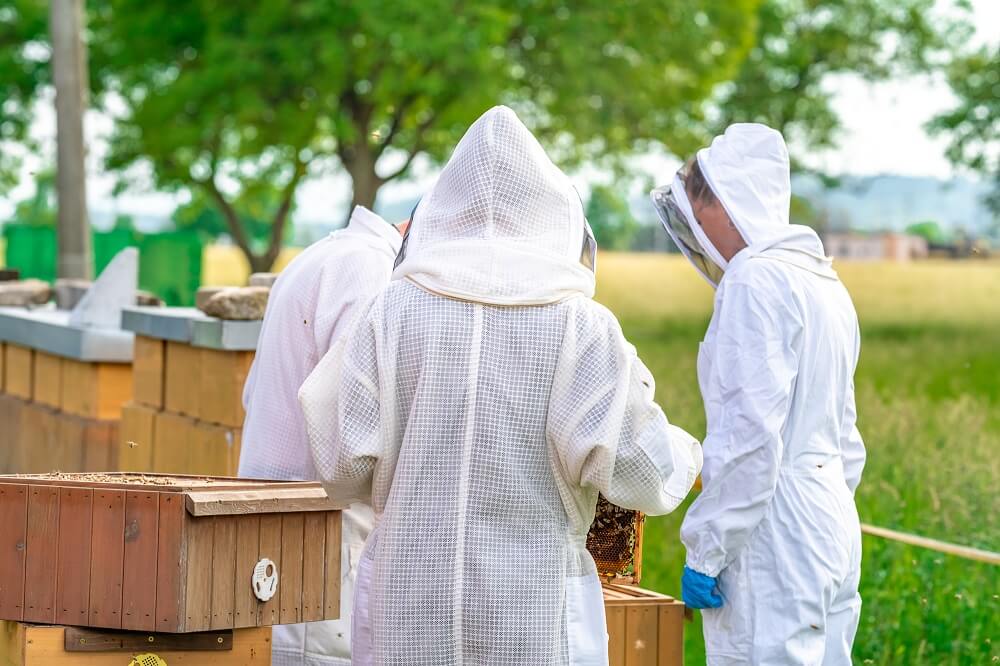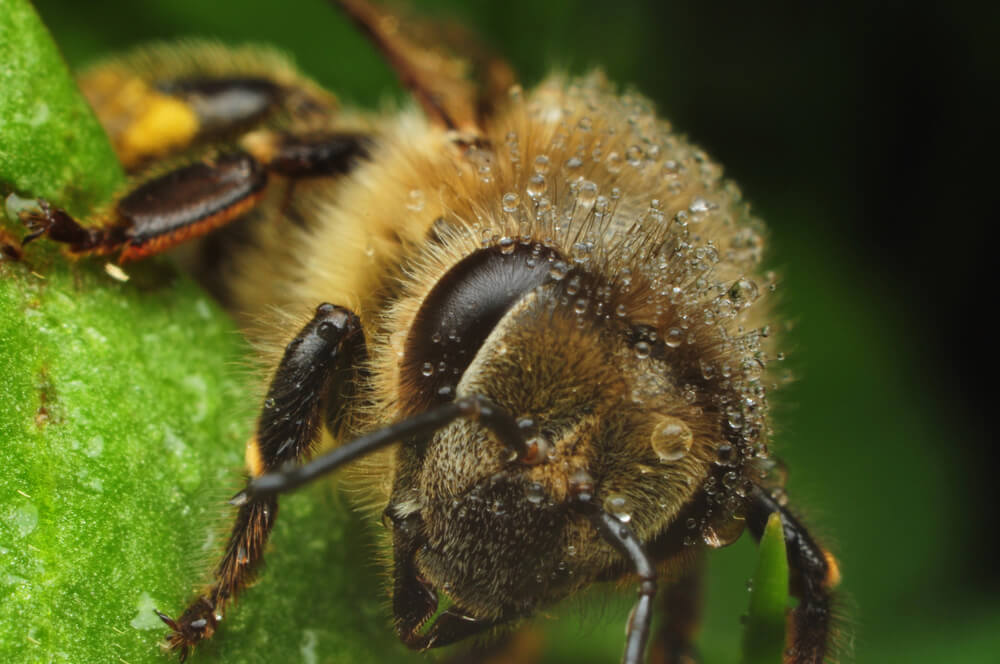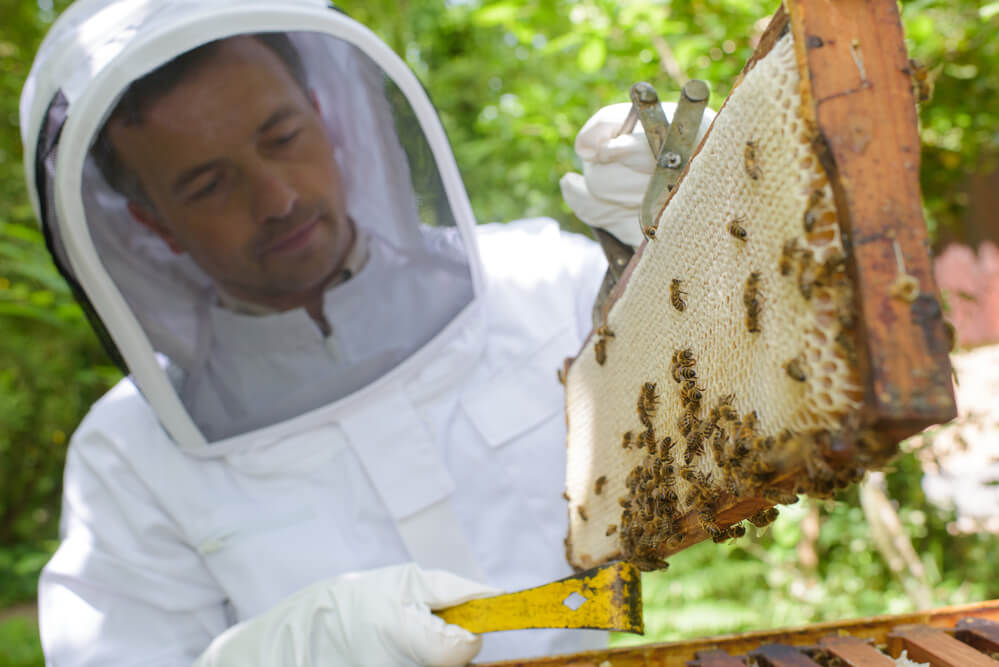Table of Contents:
What’s the Best Paint for Beehives?
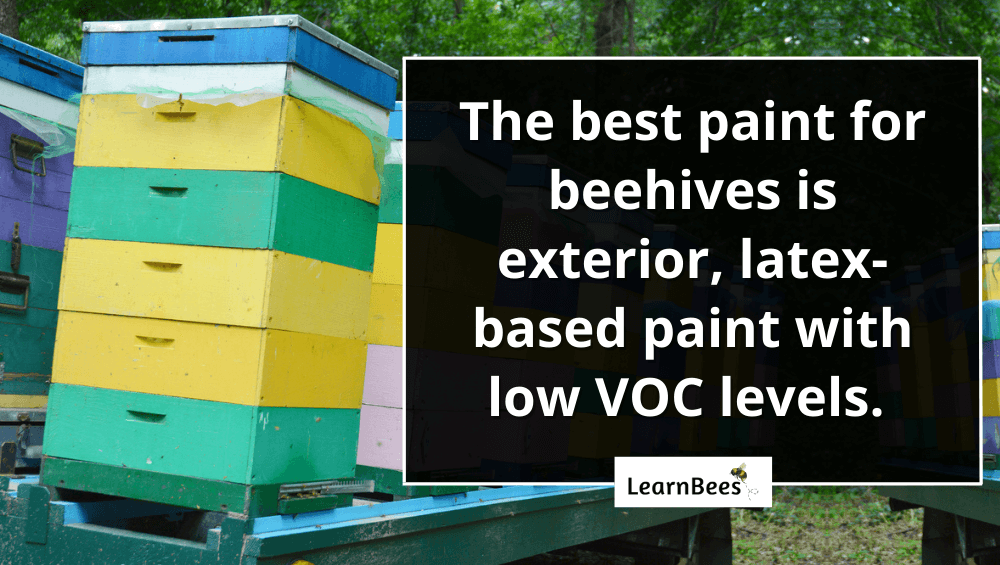
Paints with low VOC levels are the best paints for beehives.
We recommend using low VOC paints because they don’t contain as many harsh chemicals that harm your bees.
Now you might be asking:
What type of paint should I get?
There are three things you’re looking for when choosing the right paint:
- A paint rated for exterior use since your beehive is exposed to the outdoor elements
- Preferably a latex paint (water-based) rather than an acrylic-based paint
- A paint with low levels of VOCs, which is a chemical that can negatively affect your bees
VOC stands for volatile organic compounds. VOCs are chemicals that evaporate from the paint as it dries and cures, a process known as off-gassing.
You want to find paints with VOCs under 50. Low VOC levels reduce the chance that the chemicals will affect your bees and their pheromones.
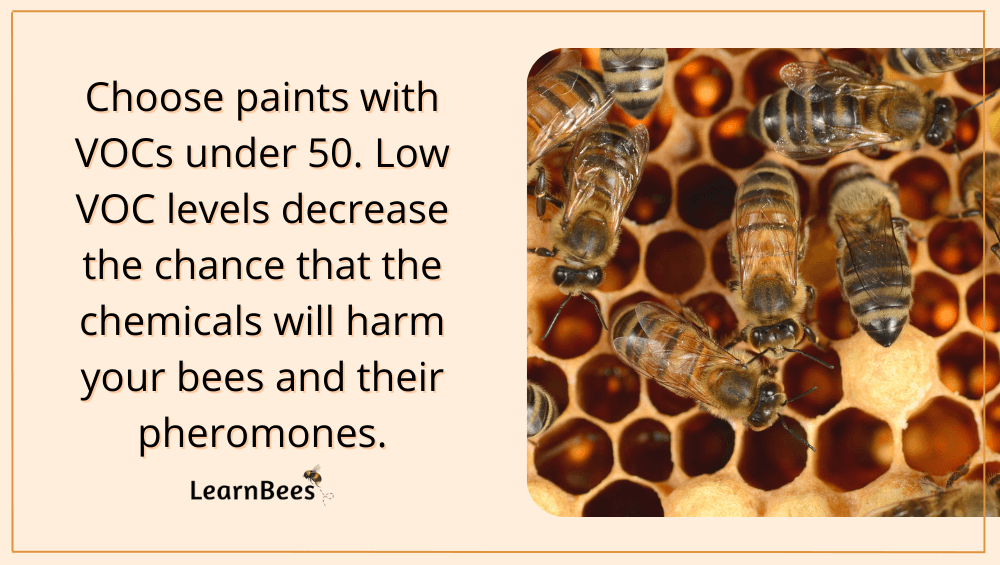
Now, the question becomes:
What color should I paint my beehive?
It depends on your climate and preference.
For example, beekeepers in colder climates tend to paint their hives with darker colors that help absorb the sun’s heat during the winter. The idea is that this can help honeybees survive the harsh cold.
In warmer climates, beekeepers often paint their hives white or another light color. This reflects the light and keeps the hive cooler during the hot summer.
With that in mind:
It doesn’t really matter what your beehive’s color is if it’s not in the sun. So if your hive is tucked away in the shade, then the exterior paint won’t affect the interior temperature of the hive.
You can paint it one color or have multiple colors with various designs. It’s up to you.
So, in summary:
- Pick an exterior paint that’s preferably latex-based (water-based)
- Ensure the paint has zero VOCs or VOCs lower than 50
How Do I Paint a Beehive?
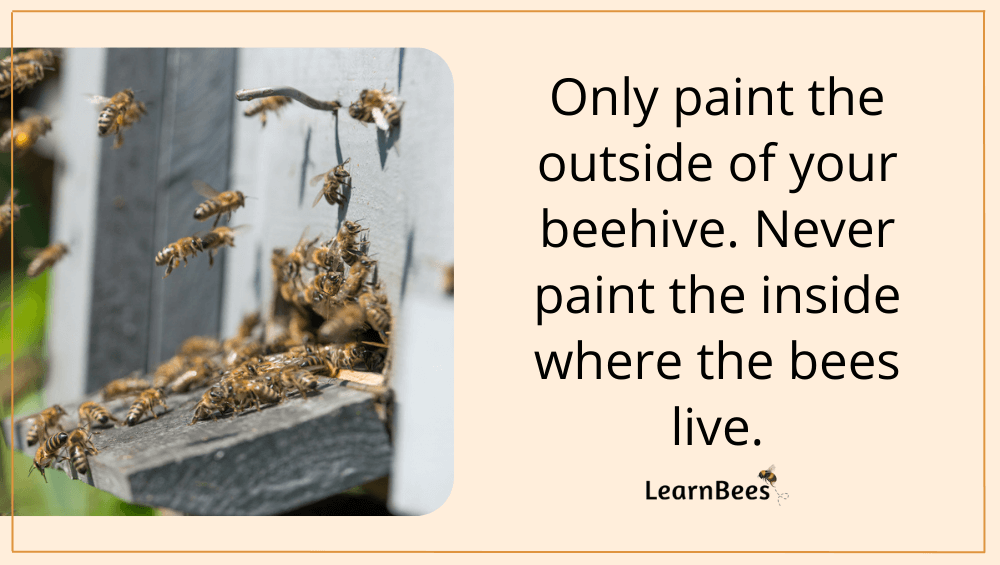
Painting a beehive is pretty straightforward. The one thing to remember is only to paint the outside of the hive – don’t paint the inside where the bees live.
Why?
Several reasons.
Reason #1: Most paints, even the low VOC kinds, contain harsh chemicals you don’t want your bees to eat.
For example, you don’t want to paint entrance reducers because your bees could chew them while trying to make a larger opening. As such, your bees would be ingesting paint.
Not good.
Reason #2: Paint takes a while to cure and stop off-gassing.
This paint smell can disrupt the pheromone signals of your bees. In contrast, the smell of wood is something bees have evolved with—the smell of paint is not.
VOCs emitted from paint dissipate over time after the paint dries on the hive. However, this process can take several weeks or even months to complete.
For this reason, we recommend letting your hive air out for at least 30 days before placing a colony inside the hive.
Reason #3: A bee’s natural environment is unpainted.
Honeybees often nest inside tree cavities and hollow logs, which are left unpainted. So leaving the interior of the hive unpainted mimics their natural living conditions.
The Parts of the Beehive You SHOULD Paint:
- Wooden Hive Stand. The hive stand comes in direct contact with moisture from the ground, so it should be painted to help it better withstand the elements. You can avoid painting your hive stand if you’re using pressure-treated wood.
- Bottom Board. Paint the exterior wood surfaces of your bottom board. Avoid painting the screen if you’re using a screened bottom board.
- Slatted Rack. Paint the exterior wood surfaces of your slatted rack.
- Hive Boxes or Supers. Paint the exterior surfaces of your hive boxes or supers. Avoid painting the interior of the boxes.
- Outer Cover. Paint the exterior wood surfaces. Avoid painting the inside/underside and the metal top.
The Parts of the Beehive You SHOULD NOT Paint:
- Entrance Reducer. Do not paint the entrance reducer because bees often chew on this piece to increase the opening. It’s normal. However, you don’t want your bees to ingest paint.
- Frames. Do not paint the frames because this is where your bees make honey and raise their young.
- Inner Cover. Do not paint the interior of the inner cover. You can paint the strip along the exterior.
Can I Paint My Beehive With Bees in It?
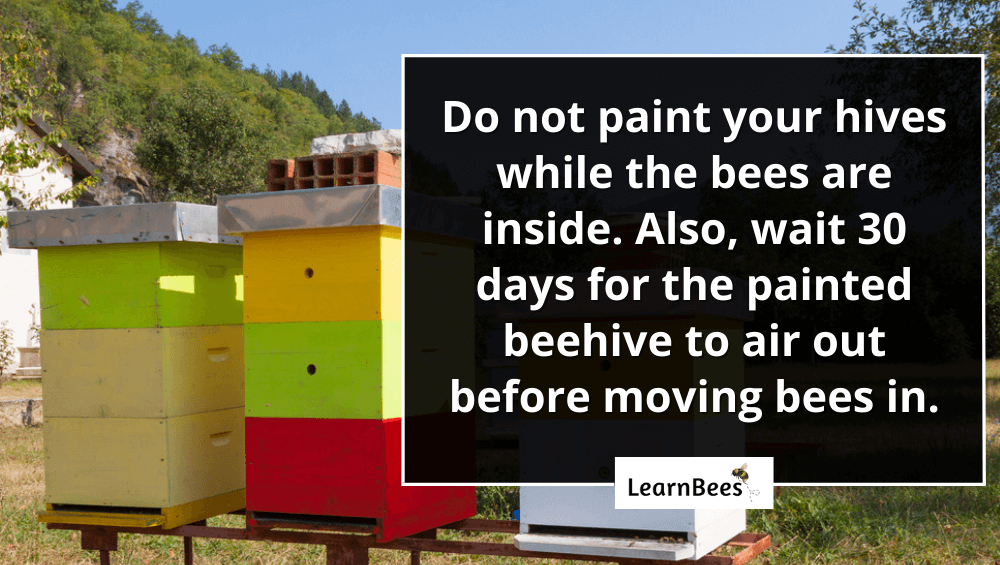
No.
If you want the best for your bees, wait at least 30 days for the painted beehive to air out. In the meantime, you can move your bees to another hive while the old one is being repainted.
Here’s the thing:
As the paint dries, the chemicals start to evaporate, leading to that familiar “new paint” smell. These fumes release harmful volatile organic compounds (VOCs) in the air. VOCs have been found to cause a wide range of adverse health effects.
VOCs are harmful to both bees and humans. As such, you should limit your bee’s exposure to such chemicals.
More importantly?
You don’t want to deal with bees flying around while painting. They can land on the wet paint and get stuck or covered in it.
That’s bad news.
Despite this, you’ll surely find beekeepers, online articles, and videos telling you it’s perfectly okay to paint your beehive while the bees are still inside.
But we do not recommend it.
Bees are vital little pollinators that do a great service to our ecosystems. That’s why we always recommend doing what’s best for your bees first.
FAQs on Paint for Beehives
- What kind of paint do you use on beehives?
- What color do bees like the most?
- Why are beehives painted white?
- Why are beehives painted different colors?
- What do you seal a beehive with?
- Can you use Kilz on a beehive?
- Is paint toxic to bees?
- Do bees like white or black painted beehives?
- Can I paint my beehive red?
- Does hive color matter?
- How do you weatherproof a beehive?
- Can I use polyurethane on beehives?
- Can you paint beehives with acrylic paint?
- Is it better to paint or stain a beehive?
- Do you paint the landing board of a beehive?
What kind of paint do you use on beehives?
People often ask:
Do you need special paint for beehives? Can you use any paint on a beehive?
You need to use water-based latex paint that’s suitable for exterior use. It should also have VOC levels lower than 50, so the chemicals aren’t too strong to harm your bees.
—> Go back to the FAQs on paint for beehives
More to Explore:
What color do bees like the most?
Bees don’t care about the exterior color of the hive. Only beekeepers do.
Hives are painted to protect the wood and be aesthetically pleasing to the beekeeper. Beyond that, it really doesn’t matter what color you paint the hive.
Some beekeepers in cooler climates use darker paint on their hives to help absorb heat during the harsh winters. Other beekeepers in warmer climates use lighter colors to deflect heat during summer.
However, if your beehive isn’t placed in the sun, then it doesn’t really matter.
—> Go back to the FAQs on paint for beehives
More to Explore:
Why are beehives painted white?
White paint is cheap and easy to find. It also reflects heat, which is great for hot summer days in hot climates.
—> Go back to the FAQs on paint for beehives
More to Explore:
Why are beehives painted different colors?
Beehives are painted to preserve the wood. The colors beekeepers choose often depend on their personal preferences. Some beekeepers even paint pretty murals on the side of their beehives. It’s entirely up to you.
It isn’t necessary to paint your beehive, but it will make it last longer. Paint protects the wooden parts from the sun, rain, snow, and other natural elements.
—> Go back to the FAQs on paint for beehives
More to Explore:
- How Many Bees Are in a Hive?
- What is Backyard Beekeeping?
- Honey Extractors 101: Everything You Need to Know
What do you seal a beehive with?
If you want to waterproof your beehive without painting it, we recommend using linseed or tung oil. Paint it on and repaint it every year or two. You can do it with the bees in the hive – they don’t seem to mind.
However, don’t add beeswax to the oil because it increases the chance of bringing wasps, robbing bees, and wax moths to your hive on hot days.
—> Go back to the FAQs on paint for beehives
More to Explore:
Can you use Kilz on a beehive?
We don’t recommend using Kilz because it has high VOC levels, which can be bad for your bees.
—> Go back to the FAQs on paint for beehives
More to Explore:
Is paint toxic to bees?
Paint can be toxic or harmful to your bees if not used correctly. For one, you should never paint your hive while the bees are inside of it. Paint – even the kind with low VOC levels – will release chemicals into the air that can disturb and even kill your bees.
If you’re going to paint your hive, you should move your bees to another hive first. Then paint the hive and give it 30 days to “air out” before putting any bees back in it.
You can also try using linseed oil to stain your beehives. This will protect your wood and not hurt your bees. You can stain the exterior of your hives using linseed oil while the bees are still in it.
—> Go back to the FAQs on paint for beehives
More to Explore:
- What is a Super for Bees?
- What Do Beginner Beekeepers Need?
- What Are the Langstroth Hive Dimensions?
Do bees like white or black painted beehives?
Truthfully, it doesn’t really matter to the bees. Painted hives are mostly for the beekeeper to protect the wood and be aesthetically pleasing.
In their natural environment, honeybees live inside tree cavities or hollow logs. They pick locations based on how safe and suitable they are – and that has very little to do with color.
—> Go back to the FAQs on paint for beehives
More to Explore:
Can I paint my beehive red?
Yes, you can paint your beehive red. Your honeybees don’t really mind what color you paint the hive – remember only to paint the outside of the hive. Never paint the inside of the hive where the bees live.
—> Go back to the FAQs on paint for beehives
Does hive color matter?
No, your honeybees don’t care about the color of the hive. This is why you see beehives painted in different colors, sometimes even with unique designs. It doesn’t matter to the bees.
In a more practical sense, it can be helpful to paint your hive based on your climate.
For example, white or light colors tend to reflect heat, which may be ideal for someone living in a hot climate. Darker colors absorb heat, which may be suitable for someone living in a cold climate.
—> Go back to the FAQs on paint for beehives
How do you weatherproof a beehive?
You can paint or stain the exterior wood surfaces of the hive to weatherproof it.
—> Go back to the FAQs on paint for beehives
Can I use polyurethane on beehives?
Yes, as long as the polyurethane contains low level of VOCs and you give the beehive 30 days to air out after using it.
—> Go back to the FAQs on paint for beehives
Can you paint beehives with acrylic paint?
Yes. But try to find acrylic paint with low levels of VOCs. With that said, latex paint is better because it’s water-based instead of chemical-based. Therefore, it’s better for your bees.
—> Go back to the FAQs on paint for beehives
Is it better to paint or stain a beehive?
It depends on what you prefer. Some beekeepers prefer the painted look because they can add color or make cool designs. Paint also lasts longer.
But some beekeepers prefer the stained, natural look.
Either way, it doesn’t really matter as long as the wood is protected. If you’re concerned about what the bees will like, don’t be. The bees don’t care whether you paint or stain the exterior of the hive. Just make sure you don’t paint the inside of the hive where the bees live. The harsh chemicals can harm the bees if they chew on it.
—> Go back to the FAQs on paint for beehives
Do you paint the landing board of a beehive?
Yes, you should paint all wood surfaces exposed to sunlight or weather. Do not paint interior surfaces.
